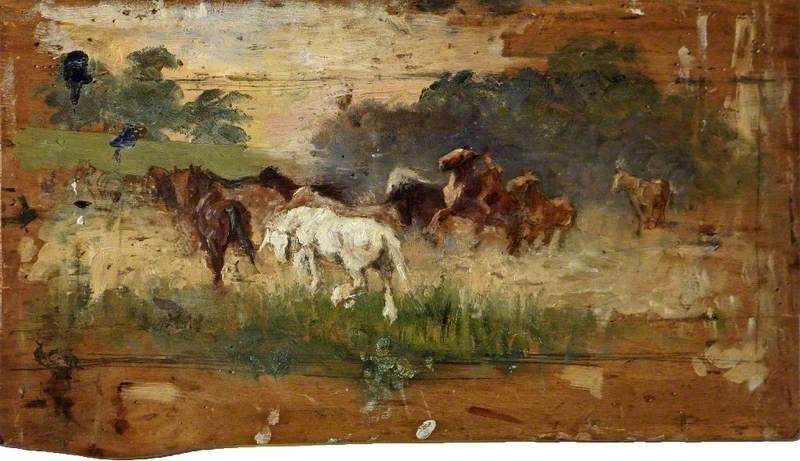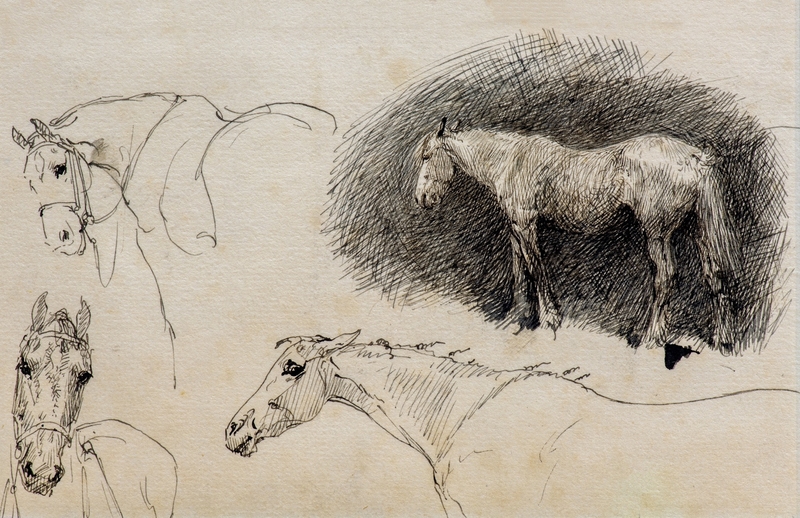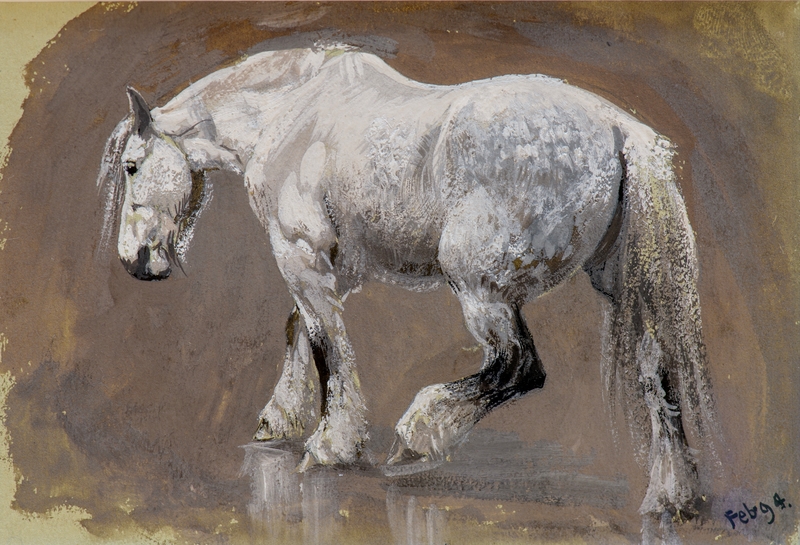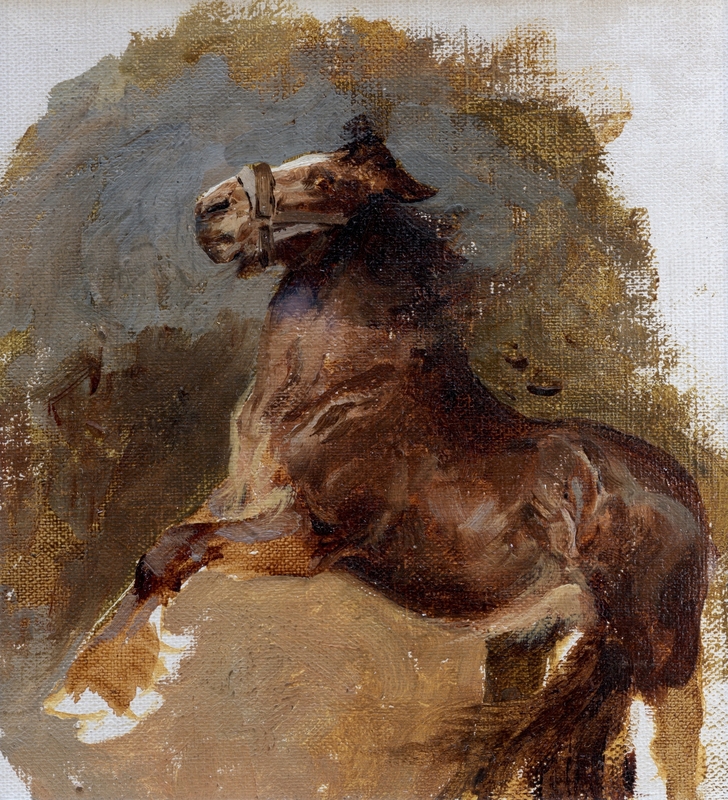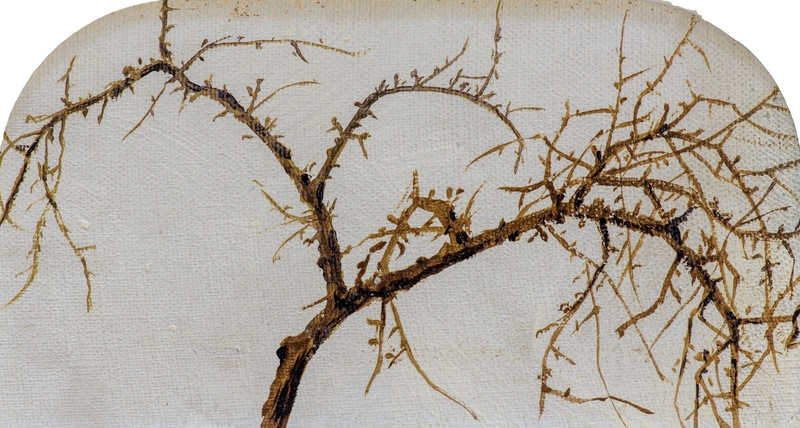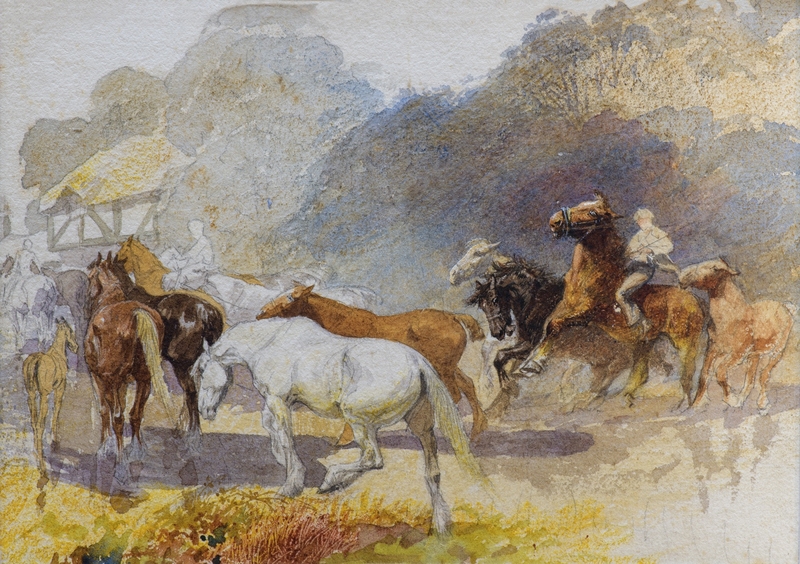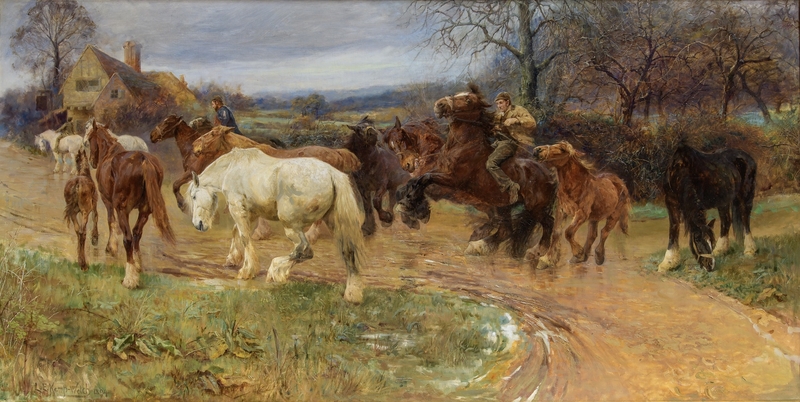The Russell-Cotes Art Gallery & Museum, is thrilled to announce the acquisition of a significant group of sketches by celebrated Bournemouth-born artist, Lucy Kemp-Welch. This landmark acquisition, made possible with funding from the Arts Council England/V&A Purchase Grant Fund and Art Fund, adds 5 sketches to the Russell-Cotes’ permanent collection.
These sketches were for her breakthrough painting, Gypsy Horse Drovers, purchased by Merton Russell-Cotes, founder of the museum and admirer of her work, in 1917. We are extremely lucky to know about the development of the painting, and these new sketches complete the story, offering a unique perspective into Lucy Kemp-Welch’s creative processes.
-
Study for 'Gypsy Horse Drovers' 1895
As a young girl, Lucy showed a prodigious talent for drawing and received informal art lessons in both Poole and Christchurch. Following the death of her parents, moved to Bushey, Hertfordshire to study at the Herkomer School of Art. Lucy had only been at art school for a few terms when she saw from her window, a group of Romani men, driving horses down the muddy road through Bushey to Barnet Horse Fair.
Realising at once that it would make an excellent subject for a painting, she rushed from her house with the nearest object to hand – the lid of her paint box. She used it to make what she called this ‘lightening sketch of the scene’ in oil, as the group stopped on the green by a pub.
Lucy Elizabeth Kemp-Welch (1869–1958)
Oil on panel
H 19 x W 33 cm
Russell-Cotes Art Gallery & Museum
-
Gypsy Horse Drovers 1894
Lucy would later describe how she knew instantly that the scene would make a fantastic painting, but humbly admitted she felt ‘hampered by the fact I was not yet out of preliminary school’.
Determined to do the work justice, Lucy produced these sketches to enable her to work up the final tone and composition for the gigantic ‘Gypsy Horse Drovers’, before she committed oil to canvas.
These sketches demonstrate the pure magic of Lucy. With just a few swift fluid lines, she is able to accurately capture the anatomical features and characteristics of the grey horse. Lucy admitted to carrying a sketchbook at every ‘conceivable occasion’ and her innate ability to commit careful observation from life, to paper, filled her works with dynamism.
Lucy Elizabeth Kemp-Welch (1869–1958)
Ink on paper
H 10 x W 15.1 cm
Russell-Cotes Art Gallery & Museum
-
Study for the 'Gypsies' 1894
In this study Lucy has focused on the tonal effects of the grey horse, which would be the central figure in the final work. In the completed painting the grey effect to the horse’s coat is achieved from a few well-chosen large sweeps of her brush, whereas this small-scale painting is made up of tiny strokes of grey, white and black.
Lucy Elizabeth Kemp-Welch (1869–1958)
Gouache on paper
H 7.3 x W 10.5 cm
Russell-Cotes Art Gallery & Museum
-
Sketch for Picture 1894
In this work Lucy has focused her attention on the rearing horse on the right of the completed work. Her concentration remained solely on the horse; she does not include the rider in this sketch.
Her tutor and mentor, Herbert von Herkomer (1849-1914) advised her shortly after ‘Gypsy Horse Drovers’ was completed that ‘I am absolutely certain that your success lies in animal life – preferably the horses’ own life – with as much of the ‘Homo’ left out as possible…. Your figure work is in no way up to the animal work’.
Throughout Lucy’s career, it was the horse that was the star, lovingly depicted, with human figures almost an accessory to their mounts.
Lucy Elizabeth Kemp-Welch (1869–1958)
Oil on paper
H 14.2 x W 13 cm
Russell-Cotes Art Gallery & Museum
-
Study of Apple Tree for 'Gypsies' 1894
Lucy’s meticulous eye for detail can been seen in this beautiful sketch of the apple trees that feature in the background of ‘Gypsy Horse Drovers’.
Lucy’s photographic memory was refined as a child, when as a favourite pastime she would explore the wilds of the New Forest with her father, Edwin, and sister, Edith. When the girls returned home, their mother, Elizabeth, would ask her daughters to sketch from memory the flora and fauna they had seen.
Throughout her career, Lucy refused to use photographs as a working aid for her painting, rejecting the process as ‘a dreadful shortcut where ‘memory and observation are both impaired’.
Lucy Elizabeth Kemp-Welch (1869–1958)
Oil on paper
H 8.2 x W 15.2 cm
Russell-Cotes Art Gallery & Museum
-
Compositional Watercolour Study for 'Gypsy Horse Drovers' 1894
Lucy was equally skilled at working on both small and large-scale works. The finished canvas for ‘Gypsy Horse Drovers’ measures 8ft x 9ft canvas (Lucy herself was only 5ft tall) and was so large it did not fit into her studio, sticking out through the door. Later in her career, she had giant doored crates created so she could work en plein air. However, in the early stage in her career she was studio bound, so relied on her incredible visual memory and meticulous sketches to create her masterpieces.
Lucy Elizabeth Kemp-Welch (1869–1958)
Watercolour on paper
H 13 x W 18.4 cm
Russell-Cotes Art Gallery & Museum
-
Gypsy Horse Drovers
Gypsy Horse Drovers 1895Professor von Herkomer was astonished when he first saw it. It seemed incredible a young, inexperienced student – and a tiny woman at that – could have painted such a vast and accomplished picture.
Lucy was delighted by Herkomer’s response. She later wrote that ever afterwards ‘he never ceased to be the kindest and sincerest critic and guide, that ever a young painter had.’ It was the first painting she exhibited at the Royal Academy, in 1895. The painting sold before the exhibition opened and the copyright bought by the Fine Art Society, success beyond Lucy’s wildest dreams.
Lucy Elizabeth Kemp-Welch (1869–1958)
Oil on canvas
H 120 x W 242.5 cm
Russell-Cotes Art Gallery & Museum
-
In 1904, Lucy's great friend and mentor, Hubert von Herkomer announced his intention to retire from teaching and sell his art school. Fearful of the loss to the study of art in England - particularly for young women, Lucy bought the school. She became the first female principle of a British art school with pupils of both sexes, at a time when women were still not accepted as teachers at many art schools, including the Royal Academy and Slade. Lucy is in the centre of this photograph, amongst her fellow teachers and predominately female students. She is holding the bridle of her favoured mount, Black Prince, who would become famous as the model for Lucy's illustrations for 'Black Beauty'.
Photograph of Students and Staff from The Bushey School of Painting, about 1910
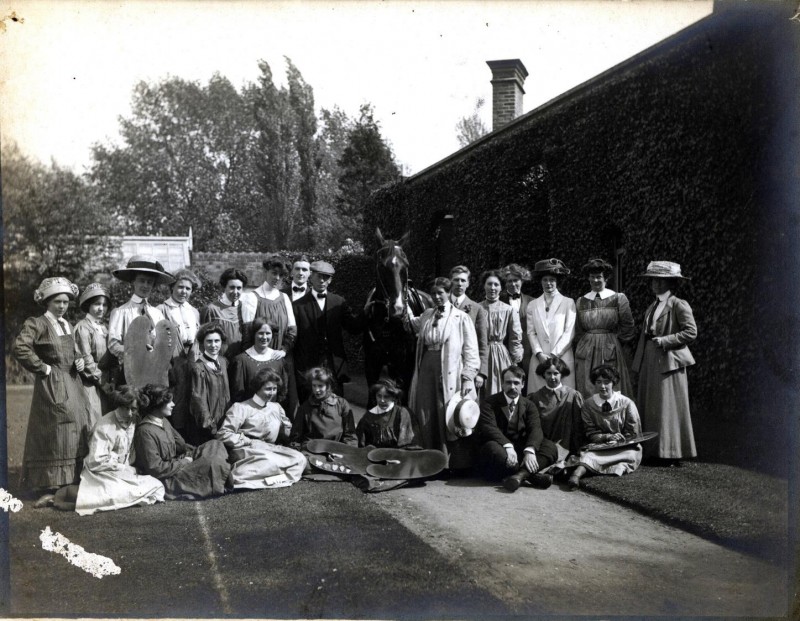 Image credit: Russell-Cotes Art Gallery & Museum, Bournemouth
Image credit: Russell-Cotes Art Gallery & Museum, Bournemouth
